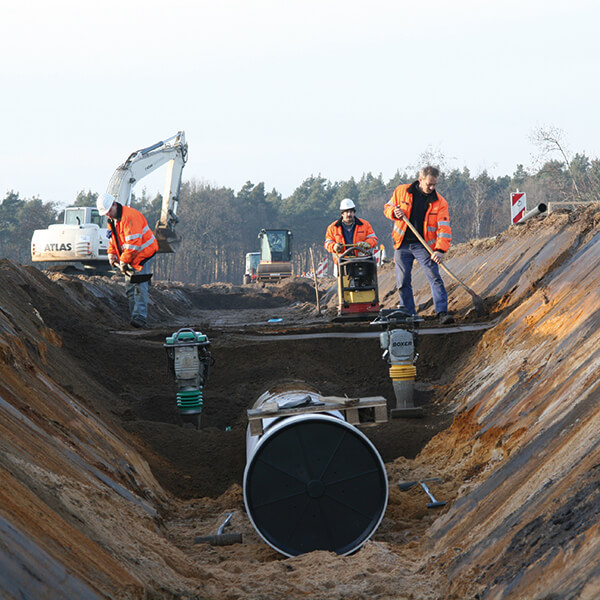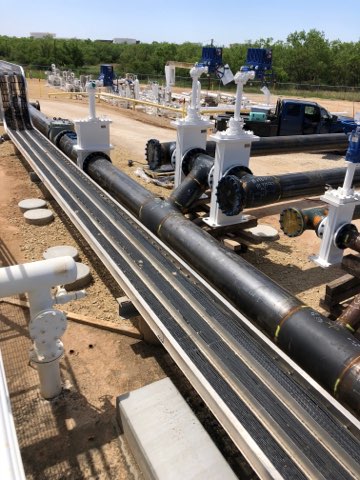Pipeline Construction Services: What Every Project Manager Should Know
Exploring the current Developments in Pipeline Construction Services for Modern Projects
The Pipeline Construction market is undertaking substantial modifications. Advancements such as wise materials and robotics are improving standard methods. These improvements promise to boost efficiency and security. Furthermore, AI innovations are boosting project monitoring capacities. As these components merge, they elevate questions concerning their long-term influence on sustainability and price. Recognizing these developments is crucial for stakeholders seeking to browse this advancing landscape. What implications do they hold for future projects?
The Surge of Smart Products in Pipeline Construction
As the need for a lot more reliable and lasting Pipeline systems increases, the integration of clever products has arised as a transformative solution in Pipeline Construction. These innovative products possess distinct properties that improve the performance and durability of pipes. Self-healing polymers can automatically fix minor leaks, considerably minimizing upkeep prices and downtime. In addition, products installed with sensors can keep track of architectural stability and ecological conditions, enabling real-time data collection and evaluation.
Smart products are corrosion-resistant and usually lightweight, which not just simplifies installment yet also expands the life expectancy of the systems. Their flexibility enables pipes to hold up against severe ecological problems, promoting safety and security and integrity. As markets increasingly focus on sustainability, using green smart materials adds to decreased environmental influence. Overall, the increase of clever materials marks a noteworthy shift in Pipeline Construction, leading the means for ingenious remedies to fulfill contemporary facilities needs.
Innovations in Robotics for Installation and Upkeep
The integration of clever products in Pipeline Construction is complemented by improvements in robotics, which are reinventing setup and upkeep processes. Robot modern technologies, such as automated welding systems and drones, boost efficiency and precision, minimizing human error and minimizing safety and security risks. These robotics can run in challenging atmospheres, guaranteeing that installations are performed in harmful or remote areas without placing employees in jeopardy.
In addition, robotic assessment tools equipped with advanced sensing units provide real-time data on Pipeline honesty, enabling positive upkeep. They can find leaks or structural weaknesses, making it possible for timely interventions that expand the life expectancy of Pipeline systems. The use of robotics not just increases the Construction timeline however also maximizes source allowance, bring about set you back savings. As these technologies remain to evolve, they are readied to play a critical role fit the future of Pipeline Construction, making certain reliability and sustainability in framework growth.
AI-Driven Job Monitoring Equipment Transforming Process
AI-driven job management devices are improving process in Pipeline Construction by boosting decision-making processes through enhanced accessibility to real-time data analytics. These devices allow groups to react swiftly to job developments, thus enhancing efficiency. Streamlined communication networks foster partnership among stakeholders, additionally optimizing project end results.
Boosted Decision-Making Procedures

Real-Time Data Analytics
Taking advantage of real-time information analytics, modern-day project administration devices transform process in Pipeline Construction. These innovative tools take advantage of synthetic knowledge to provide rapid insights right into task efficiency, resource allowance, and possible threats. By constantly keeping an eye on crucial efficiency indications, teams can promptly adapt to altering conditions, optimizing labor and materials usage. The combination of real-time data enables even more informed decision-making, reducing delays and reducing prices. On top of that, predictive analytics can determine trends and projection challenges before they rise, enhancing total task efficiency. Consequently, Pipeline Construction firms that adopt these AI-driven tools can enhance project timelines and outcomes, ensuring they remain competitive in a significantly complex market landscape. This innovation marks a considerable change toward data-centric administration practices.
Structured Interaction Networks
Efficient communication is paramount in Pipeline Construction, where numerous stakeholders have to team up effortlessly to ensure project success. The intro of AI-driven job management tools has actually changed interaction channels within the industry. These tools assist in real-time info sharing, allowing groups to accessibility updates, share records, and track progression efficiently. By automating routine tasks and providing a centralized system for communication, these developments remove misunderstandings and reduce hold-ups. Enhanced exposure right into project timelines and source allocation cultivates accountability amongst team members. In addition, AI analytics can identify prospective interaction gaps, making certain positive analytic. Ultimately, streamlined interaction channels not just boost process yet also raise overall task efficiency, allowing Pipeline Construction firms to meet modern needs efficiently.
Boosted Security Methods Via Innovation Assimilation
The assimilation of technology in Pipeline Construction has led to boosted safety and security protocols. Real-time tracking systems, wearable safety tools, and automated risk evaluations are currently necessary components in minimizing dangers on task sites. These technologies not only improve employee safety and security yet additionally simplify conformity with sector guidelines.
Real-Time Surveillance Equipments
Exactly how can real-time tracking systems transform Pipeline Construction security protocols? By integrating innovative innovation, these systems supply constant surveillance of Construction activities, guaranteeing immediate detection of prospective risks. Sensing units and cameras can keep an eye on environmental problems, devices performance, and labor force motions, providing crucial information in genuine time. This proactive approach permits job managers to recognize dangers before they intensify, significantly enhancing precaution on-site. On top of that, real-time surveillance assists in conformity with governing requirements, guaranteeing that safety and security standards are fulfilled constantly. The capacity to analyze information instantaneously supports enlightened decision-making, making it possible for timely interventions. As an outcome, Pipeline Construction jobs can operate more effectively while securing the wellness of employees and minimizing crashes, consequently revolutionizing the market's safety and security landscape.
Wearable Security Devices
Frequently, wearable safety tools are being incorporated right into Pipeline Construction to improve safety and security protocols. These cutting-edge tools, consisting of clever helmets, vests, and wristbands, are designed to keep an eye on employee health and environmental conditions in real-time. Furnished with sensing units, these tools can discover threats such as poisonous gas direct exposure, extreme warmth, or high sound degrees, providing prompt informs to workers and managers. Furthermore, wearable technology often moved here includes GPS tracking features, enabling efficient location monitoring of personnel on-site. This ability not only aids in fast response throughout emergency situations however additionally improves total job monitoring. By prioritizing employee safety and security via innovation assimilation, Pipeline Construction firms are making substantial strides in minimizing crashes and advertising a society of security within the industry.

Automated Risk Analyses
While typical danger evaluations usually count on manual analyses, the assimilation of computerized risk assessment technologies is changing safety and security methods in Pipeline Construction. These innovative systems utilize data analytics, expert system, and artificial intelligence to recognize possible threats a lot more precisely and efficiently. By continuously monitoring ecological conditions, equipment standing, and worker behavior, automated analyses supply real-time insights that improve decision-making. This positive strategy minimizes the possibility of crashes and enhances conformity with security regulations. In addition, automated risk analyses can be updated quickly, making sure that all stakeholders have access to the current information. Because of this, Pipeline Construction projects gain from a much safer workplace, reducing disturbances and promoting a culture of safety and security with innovation assimilation.
Lasting Practices in Pipeline Construction
As the demand for power framework rises, the Pipeline Construction sector progressively focuses on lasting methods that decrease ecological effect. Business are embracing green products and innovative Construction methods to minimize their carbon impact. The usage of trenchless innovation permits for Pipeline setup with minimal disruption to the surrounding environment, maintaining all-natural habitats and reducing soil disintegration.
Furthermore, the implementation of renewable resource resources, such as solar or wind, to power Construction activities is obtaining traction. This change not only lowers dependence on nonrenewable fuel sources but likewise improves the overall sustainability of Pipeline tasks. In addition, reliable waste administration practices, including reusing and reusing products, are coming to be standard in the industry.
Real-Time Tracking and Anticipating Maintenance Solutions
The change in the direction of lasting methods in Pipeline Construction has led the way for the assimilation of real-time monitoring and anticipating upkeep options. These innovations utilize progressed sensors and data analytics to continually assess Pipeline stability and functional performance. By collecting data in genuine time, drivers can spot anomalies such as leakages or stress decreases prior to they rise into major problems. This aggressive technique not just decreases ecological risks but also decreases downtime and upkeep prices.
Anticipating upkeep employs algorithms to anticipate prospective failings based upon historical information and current efficiency metrics. This enables timely interventions, optimizing upkeep timetables and source allocation. In general, real-time surveillance and anticipating maintenance options represent a considerable innovation in Pipeline Construction, improving security and reliability while supporting sustainability goals. As sectors proceed to accept these technologies, the functional landscape of Pipeline management is readied to progress substantially, making sure long-lasting viability and performance.
The Function of Drones in Surveying and Inspection
Drones have actually become transformative devices in the checking and inspection of pipes, providing enhanced performance and accuracy. Their capacity to catch high-resolution images and video clips from various angles permits for detailed analyses of Pipeline stability without risking human safety. Geared up with innovative sensors and thermal imaging abilities, drones can identify leaks, rust, and structural anomalies that may not show up to the nude eye.
The implementation of drones substantially decreases assessment time, enabling quicker decision-making for maintenance and repair services. This efficiency equates to set you back financial savings and marginal disruption to bordering environments. Drones can likewise access hard-to-reach locations, such as rugged surfaces or raised structures, further expanding the extent of evaluations.
As the Pipeline market remains to welcome technical advancements, the integration of drones into checking and assessment original site procedures is anticipated to expand, establishing brand-new criteria for functional quality and safety and security in Pipeline Construction services.
Often Asked Concerns
What Are the Expenses Related To Modern Pipeline Construction Innovations?
The expenses connected with modern-day Pipeline Construction technologies often include advanced products, check my blog specialized labor, and sophisticated modern technology. These factors add to higher initial financial investment, yet can cause long-lasting cost savings with enhanced efficiency and decreased maintenance requirements.
Exactly How Do Regulatory Modifications Influence Pipeline Construction Technologies?
Governing modifications significantly affect Pipeline Construction modern technologies by requiring the fostering of safer, much more effective approaches. Conformity requirements often drive advancement, leading to developments in materials, style, and Construction methods that improve general task sustainability and safety.
What Abilities Are Needed for Jobs in Advanced Pipeline Construction?

Occupations in sophisticated Pipeline Construction need knowledge in engineering concepts, task monitoring, safety protocols, and ecological regulations. Additionally, abilities in technology assimilation, team effort, and analytic are crucial for going across the intricacies of contemporary facilities tasks.
Exactly How Can Companies Make Sure Compliance With Environmental Specifications?
To guarantee compliance with ecological requirements, companies ought to apply rigorous training programs, carry out routine audits, and take on finest practices in sustainability. Engaging with stakeholders and checking governing changes even more reinforces their dedication to environmental stewardship.

What Are the Key Challenges Encountering Pipeline Construction Today?
The essential difficulties dealing with Pipeline Construction today consist of governing conformity, environmental issues, fluctuating material prices, labor shortages, and the need for sophisticated modern technology combination (Pipeline Construction Services). These aspects complicate job timelines and general efficiency in the market
As the demand for more effective and lasting Pipeline systems raises, the combination of smart materials has emerged as a transformative service in Pipeline Construction. AI-driven job administration devices are improving process in Pipeline Construction by boosting decision-making procedures with better access to real-time information analytics. While job management in Pipeline Construction has generally relied on hand-operated processes, the assimilation of sophisticated tools considerably boosts decision-making capabilities. Using real-time data analytics, modern task administration tools revolutionize operations in Pipeline Construction. Careers in innovative Pipeline Construction require know-how in design concepts, project administration, safety protocols, and ecological laws.